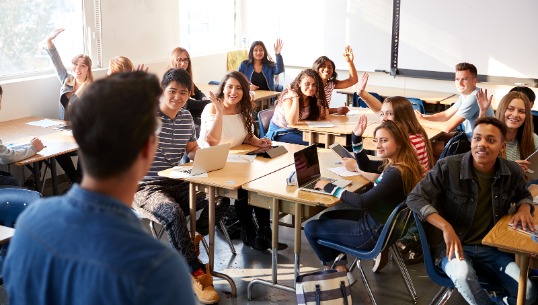
Responsive Advisory Meeting provides an effective and helpful structure for middle school teachers who are looking for opportunities to empower their students to be assertive and use their voices in the classroom and in their communities. To learn more about how Responsive Advisory Meeting can be used to support students in this endeavor, Responsive Classroom curriculum and instructional designer Amber Searles reached out to Kaylena Greenwell, a sixth grade ELA teacher at New City Charter school in Minneapolis, Minnesota. Here are some of her key insights based on her successes using Responsive Advisory Meeting with her students.
Want to learn more? Get tips and free planning lessons here or get your copy of the Responsive Advisory Meeting Book here.
Amber Searles (AS): What are some tips you have for teachers who want to use Responsive Advisory Meeting as a place where students can find their voice?
Kaylena Greenwell (KG): I believe that when it comes to student voice, Advisory is low risk, high reward. How students use their voices in Advisory can also trickle over into their academics. Keeping in mind that it is all about belonging, significance, and fun, here are some ways that I have used Responsive Advisory Meeting to help students find their voice in my classroom:
AS: You bring up a good point. So often, teachers want to be in control, and they just need to give over the control to their students. When students are given a choice, that makes them feel motivated and empowered. Because that lets them know: my teacher is listening to what we’re saying.
KG: One hundred percent, and I think it creates some really nice opportunities for learning. For example, if you are talking about a social-emotional topic, having done a bunch of Advisory meetings where you’ve provided student choice around this topic and you’ve empowered them and pushed them to step outside of their comfort zone, you’re just going to have a higher level of engagement.
AS: And I think that Advisory supports students and helps them express themselves. It’s not only setting students up for the classroom but outside of the classroom as well.
KG: I think Advisory more closely models what it looks like to have a conversation with your friends; it more closely models real-world experiences. So when you are providing students the opportunity to practice these things, you’re teaching them the skills to do it out in the real world as well.
AS: What advice would you give to teachers who are nervous about letting students have input in the classroom? How would you tell them to use Advisory to support them?
KG: I would say: slow and steady wins the race. You can start with something small that feels manageable. Then, over time, you will see the rewards.
I would also say that learning is messy. As a teacher, you have to be okay with that. It doesn’t mean that you don’t have structures in place to keep the community safe. Even with structures in place, learning can still be messy because students are actively taking risks and making mistakes. Just remind yourself, “This might feel a little messy today during acknowledgements because they are picking their own questions. But I have a structure in place, and I’m going to walk around and help remind students to use that structure.”
If you just keep practicing that, I think eventually you’ll recognize, “Oh, this is the flow of things for sixth grade, or this is how this is what it looks like for fifth graders to do this. Then, over time, you will have built up an understanding in your mind of what these activities look like.
Amber Searles is a curriculum and instructional designer for Responsive Classroom.
Kaylena Greenwell is a sixth grade ELA teacher at New City Charter school in Minneapolis, Minnesota.